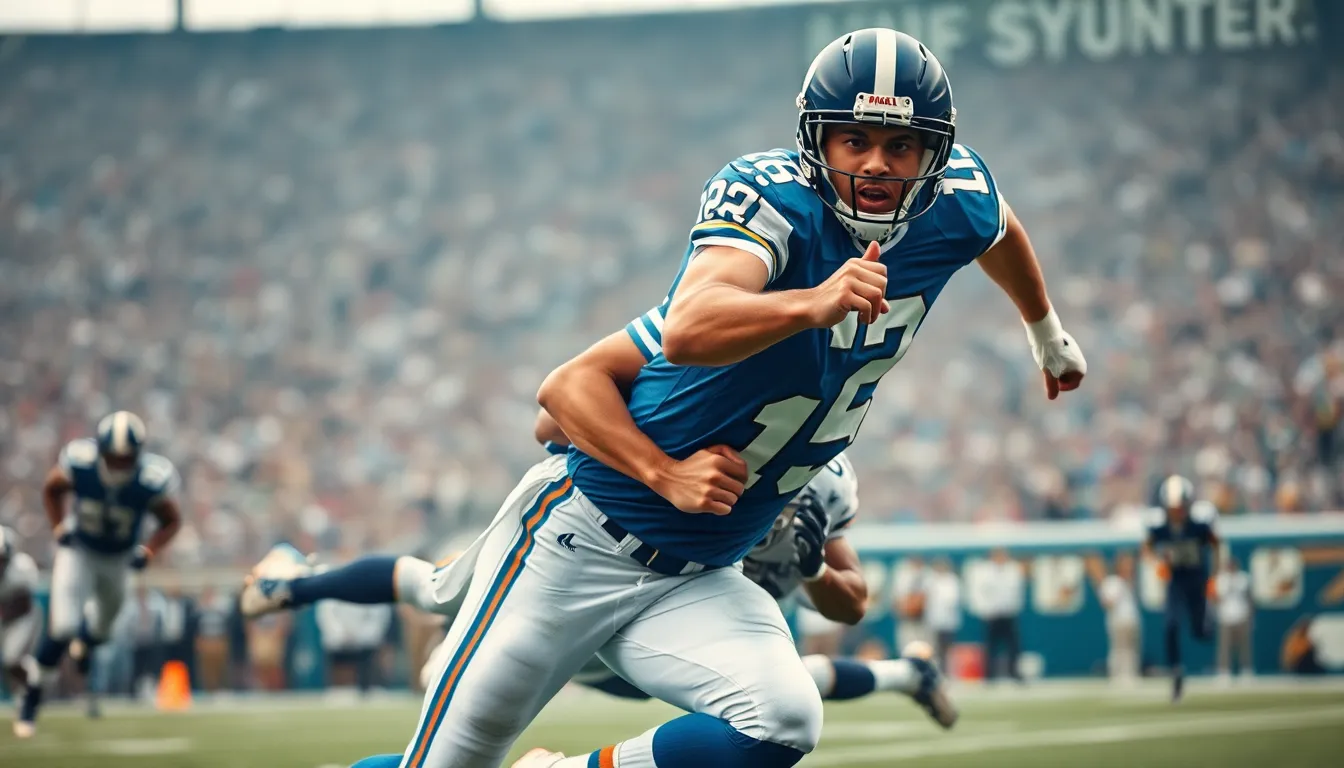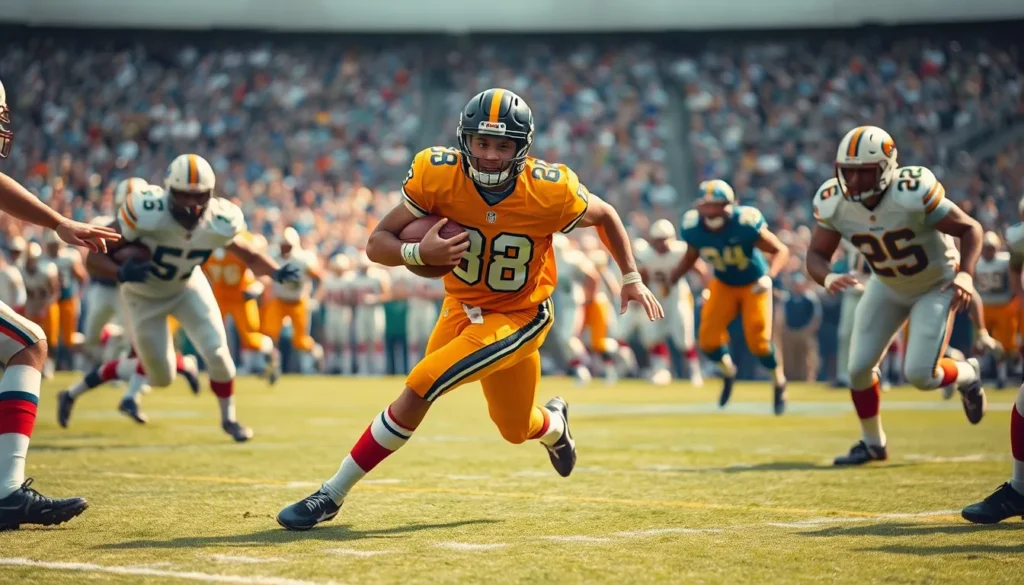Table of Contents
ToggleIn a league where height often reigns supreme, the NFL has seen some remarkable talent come in all shapes and sizes. Enter the shortest running back in NFL history, a player who defies the odds and proves that good things really do come in small packages. Standing at just 5 feet 6 inches, he’s the ultimate underdog, zipping through defenses like a squirrel on espresso.
Overview of the Shortest Running Back in NFL
Standing at 5 feet 6 inches, the shortest running back in NFL history captures attention with his unique skill set. Known for exceptional agility, he navigates through defenders with remarkable finesse. Teams often underestimate his capability, but his performance challenges typical expectations associated with height. Success in the NFL demands more than size; talent and determination play vital roles.
This player leverages speed to avoid tackles, making him an elusive asset on the field. Coaches appreciate his ability to change direction quickly, allowing for effective play execution. On numerous occasions, he demonstrated that a shorter stature doesn’t limit effectiveness; instead, it often enhances his playing style.
Throughout his career, multiple teams recognized his ability to outmaneuver taller opponents. Collectively, his achievements prove that traditional metrics of success can misjudge a player’s potential. Regularly featured in highlight reels, he showcases electrifying plays that captivate fans.
Statistics further illustrate his impact. In his best seasons, gaining over 1,000 rushing yards is not uncommon for him. His performance remains a testament to how skill, determination, and tactical acumen outweigh physical measurements. Ultimately, being the shortest running back has not hindered his success; it has instead created a narrative that inspires aspiring athletes across various sports.
Historical Context

The NFL has seen several notable short running backs who managed to excel despite height disadvantages. These players crafted remarkable careers, proving that talent often outweighs stature in professional football.
Notable Short Running Backs in NFL History
One of the most recognized names is Darren Sproles, standing at 5 feet 6 inches. His agility and playmaking ability made him a fan favorite. Another remarkable athlete, Maurice Jones-Drew, also measured in at 5 feet 7 inches, showcasing strength and balance. Both players consistently demonstrated that shorter athletes can thrive in a league dominated by taller counterparts.
Impact on Playing Style
Short running backs often rely on unique playing styles to succeed. Their agility allows for rapid direction changes, helping them evade tackles with ease. Coaches frequently value these players for their ability to make quick decisions and adapt during plays. The elusive nature of shorter running backs often leads to creative offensive strategies that exploit gaps in defenses, showcasing their pivotal role in team dynamics.
Current Shortest Running Back
The current shortest running back in the NFL stands at 5 feet 6 inches tall, continuing to demonstrate exceptional skill on the field. This player’s unique attributes challenge the norms of a league typically populated by taller athletes.
Player Profile
Darren Sproles, often recognized for his agility, embodies the essence of the modern running back. He played primarily for the San Diego Chargers, Philadelphia Eagles, and New Orleans Saints. Quick-footed and elusive, Sproles is celebrated for his ability to maneuver through defenses. His experience reflects adaptability, engaging in both rushing and receiving roles that maximize his capabilities. Often seen making sharp cuts and rapid direction changes, he exemplifies how stature does not dictate success in football.
Career Highlights
Sproles amassed over 22,000 all-purpose yards throughout his career, a remarkable statistic for any player. He notably recorded multiple seasons with over 1,000 rushing yards, showcasing his consistent performance. Additionally, he holds the record for the most consecutive seasons with at least 1,000 all-purpose yards, which further highlights his longevity. Sproles was a three-time Pro Bowl selection, underlining his talent and contributions to the teams he played for. Significant plays often featured him evading defenders and scoring crucial touchdowns, leaving a lasting impact on games.
Challenges Faced by Short Running Backs
Short running backs confront unique challenges in the NFL. Many obstacles stem from their physical stature, which can impact their visibility on the field.
Physical Limitations
Height poses significant difficulties when navigating through larger defenders. Short running backs often struggle with over-the-top tackles, resulting in increased risk for injury. Limited reach may hinder their ability to block effectively against taller opponents. Their center of gravity offers advantages for agility, but it can also make them more vulnerable in crowded situations. Less weight can lead to not getting held back during tackles; nevertheless, physical collisions can offset these qualities. Coaches often prioritize durability and resilience to withstand the rigors of the game.
Strategies for Success
Short running backs employ various strategies to thrive against taller opponents. Utilizing speed and agility enables them to swiftly change direction, creating opportunities for explosive plays. They rely on quick decision-making to exploit gaps in defenses and exploit mismatches. Tactical footwork becomes crucial during plays, allowing them to navigate tight spaces effectively. Strong communication with quarterbacks improves play execution, ensuring alignment during offensive strategies. Understanding defensive schemes helps them anticipate movements, gaining advantages against larger defenders. Consistently adapting to evolving game scenarios enhances their impact on the field.
The journey of the shortest running back in NFL history is a testament to the power of talent and determination. Standing at just 5 feet 6 inches tall he has proven that height isn’t the sole determinant of success in professional football. His agility and speed have allowed him to navigate through defenses with remarkable finesse.
As he continues to challenge expectations and inspire future generations of athletes his legacy highlights the importance of skill over stature. The impact of players like him underscores the evolving nature of the game where unique playing styles and strategic adaptability can lead to extraordinary achievements. Ultimately his story serves as a powerful reminder that greatness comes in all shapes and sizes.




